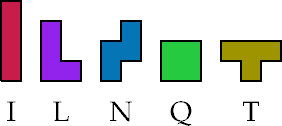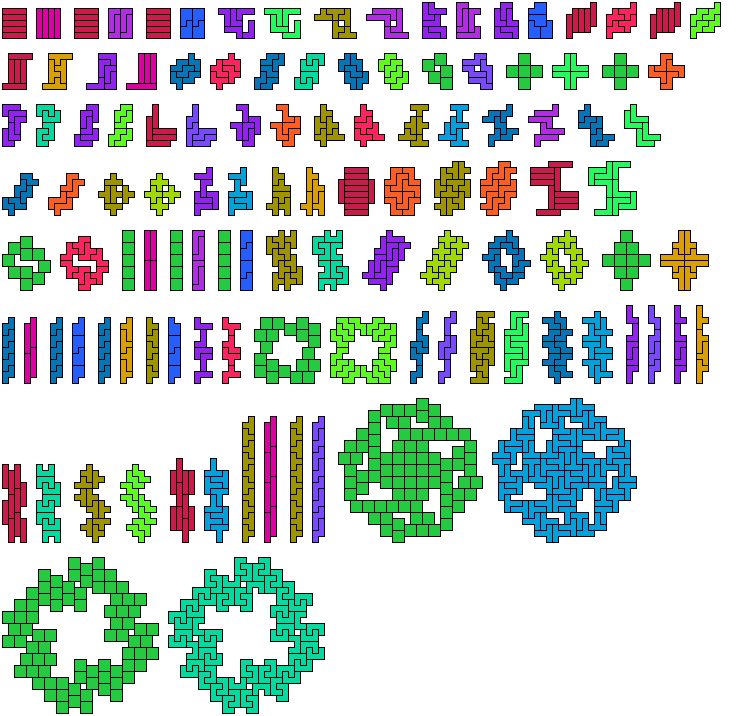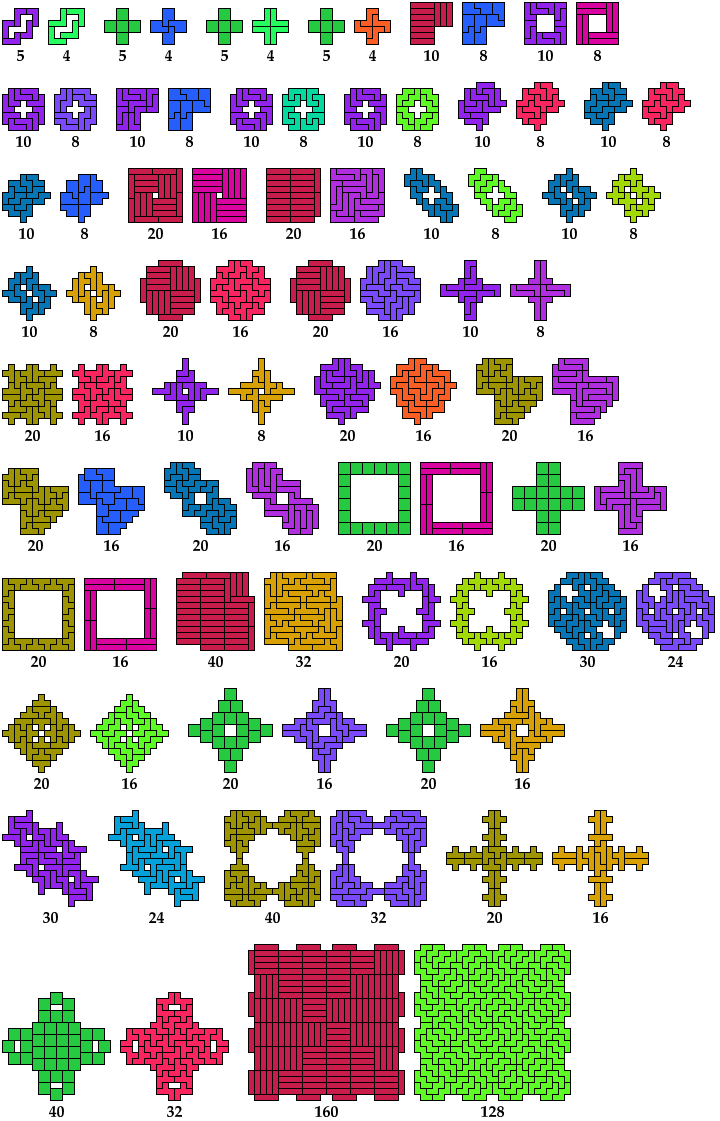
The compatibility problem
is to find a figure that can be tiled with each of a set of polyforms.
Polyomino compatibility has been widely studied since the early 1990s,
and two well-known websites, Poly2ominoes by Jorge Mireles and
Polypolyominoes by
Giovanni Resta, present the results of their authors' systematic searches
for compatibility figures.
The sites include solutions by other researchers, especially Mike Reid.
So far as I know, polyomino compatibility has not been treated in print
since Golomb first raised the issue in 1981,
except in a series of articles called Polyomino Number Theory,
written by Andris Cibulis, Andy Liu, Bob Wainwright,
Uldis Barbans, and Gilbert Lee from 2002 to 2005.
Here I show minimal known tetromino-pentomino compatibility figures, allowing or disallowing holes. If you find a smaller solution or solve an unsolved case, please let me know.
The solution shown below for the square tetromino and the T pentomino is a variant of the minimal solution found in 2011 by deepgreen. His home page is here.
For compatibility of two pentominoes with or without holes, see Pentomino Compatibility. Resta's page of tetromino-pentomino compatibilities was originally on GeoCities, a defunct web host. It is now here. Mireles's site was also on GeoCities and has not been rebuilt. The link above is to the Internet Archive.


| F | I | L | N | P | T | U | V | W | X | Y | Z | |
|---|---|---|---|---|---|---|---|---|---|---|---|---|
| I | 4 5 | 4 5 | 4 5 | 4 5 | 4 5 | 8 10 | 8 10 | 8 10 | 4 5 | × | 4 5 | 8 10 |
| L | 4 5 | 4 5 | 4 5 | 4 5 | 4 5 | 4 5 | 4 5 | 4 5 | 4 5 | 8 10 | 4 5 | 4 5 |
| N | 4 5 | 4 5 | 4 5 | 4 5 | 4 5 | 8 10 | 4 5 | 4 5 | 4 5 | 8 10 | 4 5 | 4 5 |
| Q | 8 10 | 4 5 | 4 5 | 4 5 | 4 5 | 68 85 | 64 80 | 4 5 | 16 20 | × | 8 10 | 4 5 |
| T | 4 5 | 8 10 | 4 5 | 8 10 | 4 5 | 4 5 | 8 10 | 8 10 | 8 10 | 4 5 | 4 5 | 8 10 |

| F | I | L | N | P | T | U | V | W | X | Y | Z | |
|---|---|---|---|---|---|---|---|---|---|---|---|---|
| I | 4 5 | 4 5 | 4 5 | 4 5 | 4 5 | 8 10 | 8 10 | 8 10 | 4 5 | × | 4 5 | 8 10 |
| L | 4 5 | 4 5 | 4 5 | 4 5 | 4 5 | 4 5 | 4 5 | 4 5 | 4 5 | 8 10 | 4 5 | 4 5 |
| N | 4 5 | 4 5 | 4 5 | 4 5 | 4 5 | 8 10 | 4 5 | 4 5 | 4 5 | 12 15 | 4 5 | 4 5 |
| Q | ? | 4 5 | 4 5 | 8 10 | 4 5 | ? | ? | 4 5 | ? | × | 8 10 | 4 5 |
| T | 4 5 | 8 10 | 8 10 | 8 10 | 4 5 | 4 5 | 8 10 | 8 10 | 8 10 | 8 10 | 4 5 | 8 10 |

| F | I | L | N | P | T | U | V | W | X | Y | Z | |
|---|---|---|---|---|---|---|---|---|---|---|---|---|
| I | 16 20 | 16 20 | 16 20 | 16 20 | 8 10 | ? | ? | ? | 128 160 | × | 32 40 | ? |
| L | 8 10 | 8 10 | 8 10 | 8 10 | 8 10 | 24 30 | 8 10 | 4 5 | 8 10 | 16 20 | 8 10 | 16 20 |
| N | 8 10 | ? | 16 20 | 24 30 | 8 10 | ? | ? | ? | 8 10 | 8 10 | 8 10 | ? |
| Q | 32 40 | 16 20 | 16 20 | 16 20 | 4 5 | ? | ? | 4 5 | ? | × | 16 20 | 4 5 |
| T | 16 20 | 16 20 | 16 20 | 32 40 | 16 20 | ? | ? | ? | 16 20 | ? | 16 20 | ? |

Last revised 2023-12-12.